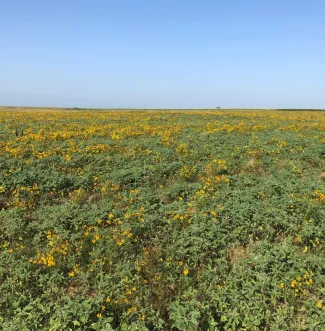Many hunters view dove season as the unofficial kickoff of hunting season. With the opener on September 1st, it leads the way into the fall and winter hunting seasons. Hunters are able to get out in moderate weather conditions and enjoy wing shooting a fast, fitful, falcon-like bird. These agile birds can be a tough target as they zig and zag while flying past. That said, a hunter will want to have shot opportunities at the most dove possible.
Doves, like any other wildlife species, are looking for key items needed for survival – food, water, shelter. By managing land accordingly an individual’s property can be manipulated and maintained to provide the item most lacking or most needed during the hunting season. Dove season coincides with dove migration. As temperatures drop in late summer and through the fall dove begin to fly south being “pushed” by cold fronts. This migration requires a lot of energy. That energy comes from the food sources made available to the dove as they migrate. Therefore, providing a grain food resource at that time of year can draw higher numbers of dove. Since doves are migratory birds, they are protected by federal regulations restricting baiting. So it will take a little more creativity to provide these needed grains.
Management practices for dove food resources legal for hunting will take place months before the season ever opens. The primary practice to provide grain for dove is through food plots. That term “food plot” likely triggered a thought process that includes working ground, purchasing seed, planting seed, and fertilizing that newly planted plot. However, there are simpler, less expensive methods for providing a food plot suitable for dove. The simplest method is disking.

Wild-growing sunflowers are one of the top dove foods in Oklahoma and are readily produced through winter disking. (Joey McAllister/ODWC)
Disking at the appropriate time of year can be used to stimulate desired plant growth. Disking conducted during the winter months, December through early March, will encourage forb growth. Forbs are best described as “weeds”, the flowering plants that wildlife desire as food, both for browse and for the seed. Among these winter stimulated forbs are native sunflower species. Sunflowers are annual plants that must grow from a seed each year. As a result, they have adapted to produce numerous seeds from a single plant. These seeds are relatively large and are a quality food source for various wildlife species, including migrating dove. To encourage germination of sunflower seeds, it is as simple as stated above, run a disk between the months of December and March. No other step is needed to produce native sunflowers. This disking can be in strips or in a traditional food plot layout.
It is spring, disking was completed in the winter, and sunflowers are beginning to grow along with other forbs and grasses. Is there something that can be done to provide the sunflower with an advantage? Though the target plant species is sunflower many of the forbs that are now growing will produce a seed that is desirable to doves. These other forb species may also alleviate browse pressure from deer and other wildlife on the sunflower plants by providing an alternative food source. However, the grasses that are beginning to grow are likely competing with these desired forbs and, in turn, providing minimal resource to wildlife. So what can be done to provide the forbs with an advantage over the grasses? Grasses and forbs are drastically different. Not only in appearance but also with how they function. As a result, some herbicides can be used to target grasses and will have no effect on forbs. Clethodim does just that. The entire disk plot can be sprayed with Clethodim resulting in the removal of grasses only. This use of herbicide is not required to produce a disk plot; however it can be an additional step to improve the plot.
In summary, a simple food plot can be installed by disking sometime during December through early March. Grass specific herbicide can be used to remove grasses competing with desired forbs. Disk plots can be strips or traditional food plot shapes or sizes. Disk plots are relatively inexpensive when compared to traditional row crop food plots.